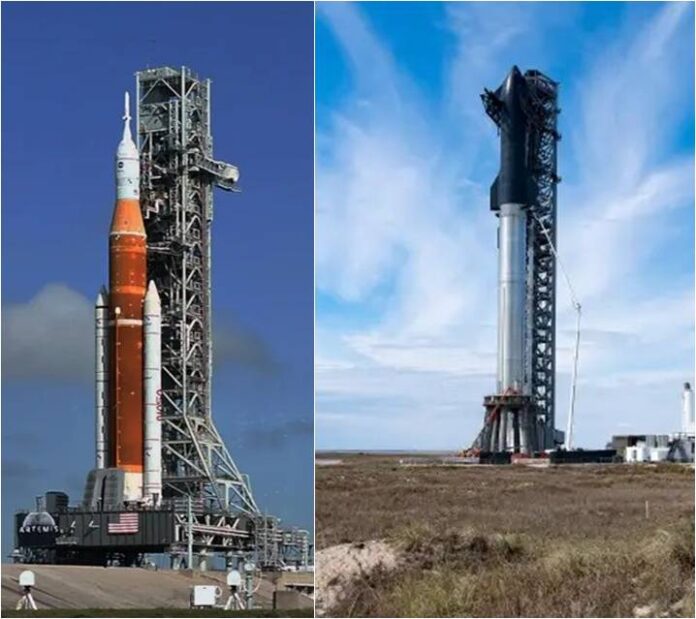Back in 2019, I asked the question, “When will NASA abandon the SLS Project?” At the time I noted that the SLS, the Space Launch System, a rocket purported to be the successor of the Saturn V, was a rehash of old throwaway technology. I stated that we already had demonstrable reusability being demonstrated by SpaceX, and modular assembly in space with the building of the International Space Station (ISS). So why was NASA continuing to back this dinosaur?
It was no surprise to me to read the latest U.S. Government Accountability Office (GAO) report that questions NASA’s entire approach to the Artemis Program, an ambitious goal to send human crews to the Moon and establish a crewed habitat there before going to Mars. The GAO report questioned the affordability of the Program, NASA’s fundamental ability to manage U.S. taxpayer money, and what the final cost will be.
When I asked the above question in 2019, I wrote that other ways were far cheaper to accomplish the goals of the Artemis Program. These entail:
- Using the SpaceX Falcon Heavy as a launch vehicle.
- Developing a modular staging strategy as in the ISS to become the launch platform for Deep Space exploration including the return to the Moon.
- Modifying the existing crew capsule to allow for docking assembly so that it could be mated to modules placed in orbit.
Since writing these three in 2019, I would revise the first point and replace the Falcon Heavy with the Starship.
NASA has done and can do all three of the items on the above list. But why no one at NASA has put an alternative plan to the SLS in place, would seem to defy logic.
The SLS evolved from several cancelled NASA programs designed to succeed the Space Shuttle. Its direction and design were first formulated in 2011 with the idea to use some of the technology from the Space Shuttle Program, and other technology on the drawing board in development from cancelled programs. This has always been one of the flaws in NASA’s approach which has been exacerbated by the four-year cycle of election politics in the U.S. leading to changes in presidential aspirations regarding space. Throughout regime changes, the return to the Moon has been the only constant. For a while, it was not to land on the Moon but to develop the horsepower to reach and go beyond it. Landing and establishing a crewed lunar base came later to explore the Moon’s environment for potential extractable resources to be used on missions on and beyond it.
SLS has never been a single rocket system. It comes in multiple iterations of which only the first has been built. So there is a lot more design and investment to make to this single-use system for getting to Deep Space. And NASA’s prime contractors have milked the Agency repeatedly for extended funds that go well beyond the original budgeted costs. In recent days, NASA has changed its contractor terms from cost-plus arrangements to firm fixed costs. But that hasn’t changed the boondoggle that is SLS. The GAO report questions the affordability of NASA’s entire approach to Artemis, and to continuing to support the SLS.
Meanwhile, SpaceX, the company that has taken over NASA’s low-Earth orbit taxi business, once the purview of the Space Shuttle and Russia’s Soyuz, has been building the completely reusable alternative to SLS called the Starship with its super heavy booster. Starship is indirectly funded by NASA since the Agency continues to buy services from SpaceX for satellite launches, supply runs and crewed missions to the ISS. The money earned from these projects has allowed SpaceX to plow it into the Starship. NASA has given SpaceX a contract for a version of the Starship to be used in the first and second Artemis lunar landings. Starship is demonstrating flexibility. Starship is reusable. And Starship comes in at a cost considerably lower than the SLS.
Here is a good example of the lack of cost awareness from NASA. The engines being used by SLS currently cost $100 million each. SLS uses several of these per launch. NASA has asked the prime contractor to get the cost down to $70.5 million each. Remember these are throwaways.
A comparable engine built by the American commercial space company, Blue Origin, comes in at $20.4 million per engine and is reusable. These could easily replace the existing SLS engines.
And then there is SpaceX and its Raptor engines which the company uses in clusters to populate the Starship and heavy launch booster. Each of these costs less than $1 million apiece and are reusable.
In the end, each Artemis SLS launch is going to cost NASA several billion dollars. Except for the Orion capsule, everything used in each of these launches gets thrown away.
SpaceX estimates each Starship mission will cost $40 million. All components of the Starship including its heavy booster will be reused repeatedly. If the current use of Falcon 9 first stages is any indicator, reuse should become a fundamental requirement for NASA’s space program including human space flight going forward. So I ask the question once again, “When will NASA abandon the SLS Project?” Or is this a case of “in for a penny,” in for billions with no escape?









